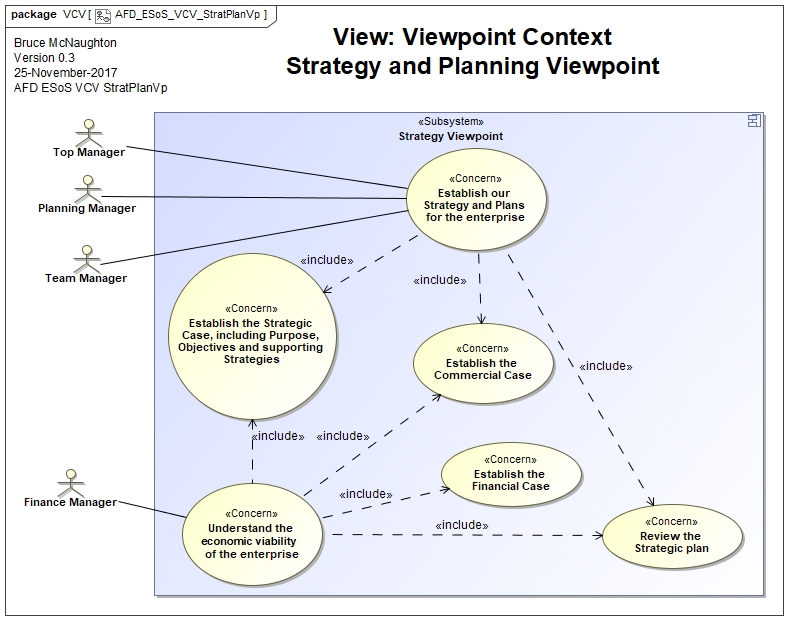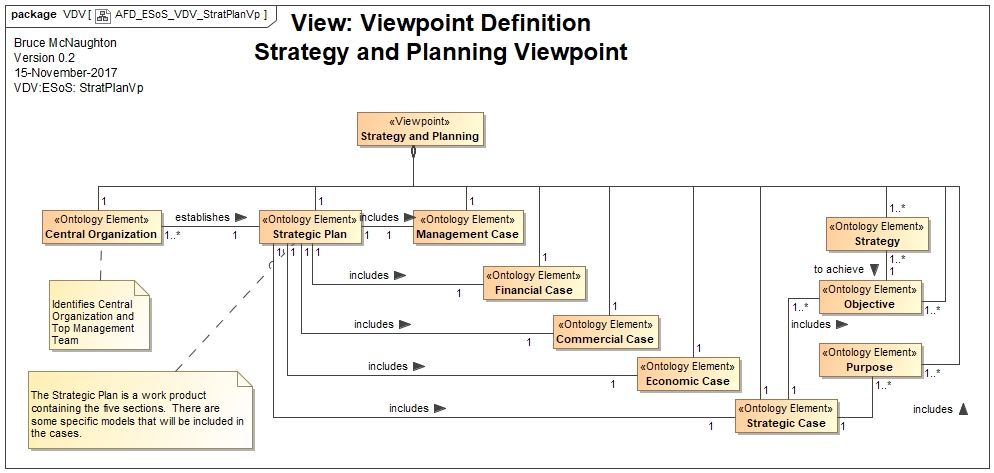Description
The Strategy and Planning Viewpoint describes the approach to creating the Strategy and Planning View for an Architecture Description.
The result of this viewpoint is a fully integrated view of the enterprise through a Strategic Plan.
The strategic plan contains the following five cases that are developed during the development of the architecture description. These cases are:
- Strategic Case
- Economic Case
- Commercial Case
- Financial Case
- Management Case
The set of cases provides an integrated view of the whole enterprise that aligns with the Enterprise Operating Model. This strategic plan is created through collaboration across the whole value system driven from customer needs and expectations.
In addition, the planning structure and timing are established and the set of capabilities needed to realize the planning system are identified.
Rationale
The Strategy Viewpoint is an integrating viewpoint across the entire Enterprise. The main result from the use of this viewpoint is an integration of the architecture description with the Strategic Plan. This means that as each of the other viewpoints are created there will be an update to the models and diagrams created along the way.
This Strategic Plan is also aligned very closely to the Enterprise Operating Model or the Enterprise (SoS) Architecture Description created from this Architecture Description Framework. The operating model can be seen in 3 dimensions. This Strategy and Planning Viewpoint provides an integrating framework for all 3 dimensions.
Stakeholders and their Concerns

Ontology Concepts and System Descriptions
System Descriptions: Enterprise, Organization, Integrated Management System. Planning System

Models
Stakeholder Model (Identifies all of the Enterprise Level Stakeholders)
Enterprise Structure Models (Identifies the types of systems in the Enterprise)
Benefits Model (Identifies all of the benefits and their impact on outcomes)
Supply Capability Model (identifies candidate capabilities to acquire externally)
Financial Cost Model (Revenue and Cost forecasts: operations and change)
Organization Chart (Enterprise Level Organization Chart)
Strategic Risk Model (Strategic Risks and Responses).
Steps to Create the View
- Create a stakeholder model
- Create an Enterprise Structure Model and Organization Chart
- Initial Draft of the Strategic Case and include:
- Purpose (reason for being), Vision, Values (Core Ideology)
- contribution to the economy, society and the individual (What is our Business?)
- Identify the customer needs and the elements necessary to satisfy those needs.
- Initial Draft of the Economic Case and include
- The Benefits Model
- The impacts on society and the customers
- Initial Draft of the Commercial Case
- Identify any initial supplier requirements
- Initial Draft of the Financial Case
- Initial Draft of the Management Case (based upon capability models and org charts)
- Review of the Strategic Plan Draft
- Revise following each View Review.
- Finalize the Strategic Plan as the last step in the creation of the Architecture Description
Correspondences
Strategic Plan Draft produced as first View completed.
Strategic Plan reviewed along with each viewpoint
Strategic Plan Reviewed and Approved as last view to complete
Examples
See the UK Green Book for an example .
Sources
- Adaptive Enterprise, Stephan Haeckel
- Built to Last, Jim Collins and Jerry I. Porras
- Complexity Works!, Denise Easton and Lawrence Solow
- Corporate Governance: Principles, Policies and Practices, Bob Tricker
- Creating the Corporate Future, Russell Ackoff
- Management: Tasks, Responsibilities and Practices, Peter Drucker
- Managing Corporate Lifecycles, Ichak Adizes, Ph.D.
- Organizational Culture and Leadership, Edgar H. Schein
- Re-Creating the Corporation, Russell Ackoff
- Requisite Organisation, Elliott Jaques
- The Puritan Gift, Kenneth Hopper and William Hopper
Notes
Started first and completed / approved last.